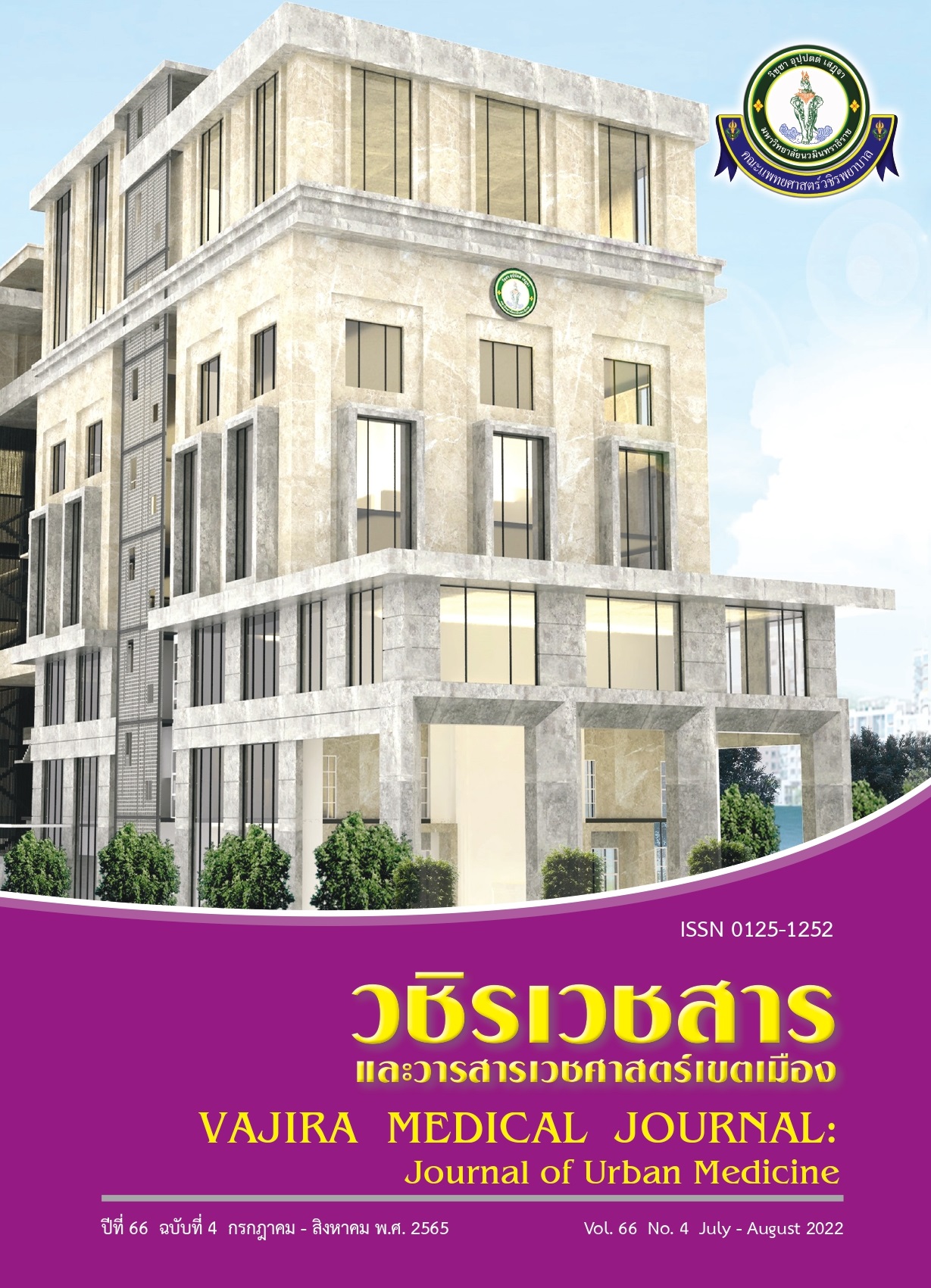The Cut-Off Value of HbA1c for Prediabetes and Diabetes among Obese Children and Adolescents
Main Article Content
Abstract
Objective: To determine the optimal cut-off value of HbA1C for prediction of prediabetes and diabetes among obese children and adolescents age 10–15 years at Faculty of Medicine Vajira Hospital.
Methods: A cross-sectional descriptive study has been performed in 230 participants between 10-15 years old who underwent an OGTT in 2015-2020. The diagnostic performance of HbA1c for prediabetes and diabetes was determined using the area under the Receiver operating characteristic curve.
Results: The prevalence of prediabetes and diabetes was 35.2% and 3.1%, respectively. The kappa coefficient for agreement between OGTT and HbA1c was 87.07%. The optimal HbA1c cut-off value were ≥ 5.5 (AUC, 0.565; a sensitivity of 65.4% and a specificity of 45.1%) for prediabetes and ≥ 6.6 (AUC, 0.644; a sensitivity of 42.9% and specificity of 99.1%) for diabetes.
Conclusion: HbA1c has low sensitivity and specificity for diagnose prediabetes. HbA1c has low sensitivity but high specificity for predicting diabetes in Thai children and adolescents.
Downloads
Article Details

This work is licensed under a Creative Commons Attribution-NonCommercial-NoDerivatives 4.0 International License.
References
Jirapong A. KM & Innovation in urban medicine 2017. Bangkok: Faculty of Medicine Vajira Hospital, Navamindradhiraj University; 2017.
Vichai A. Thai National Health Examination Survey 5. Bangkok: Health Systems Research Institute; 2014.
Ichihara S, Yamada Y. Genetic factors for human obesity. Cell Mol Life Sci 2008;65(7-8):1086-98.
Mo-suwan L, Geater AF. Risk factors for childhood obesity in a transitional society in Thailand. Int J Obes Relat Metab Disord 1996;20(8):697-703.
Dubois L, Girard M. Early determinants of overweight at 4.5 years in a population-based longitudinal study. Int J Obes (Lond) 2006;30(4):610-7.
Galvez MP, Hong L, Choi E, Liao L, Godbold J, Brenner B. Childhood obesity and neighborhood food-store availability in an inner-city community. Acad Pediatr 2009;9(5):339-43.
Tremblay MS, Willms JD. Is the Canadian childhood obesity epidemic related to physical inactivity? Int J Obes Relat Metab Disord 2003;27(9):1100-5.
Obesity: preventing and managing the global epidemic. Report of a WHO consultation. World Health Organ Tech Rep Ser 2000;894:1-253.
Suntree R. Prevention and treatment of pediatric obesity: an endocrine society clinical practice guideline 2014. Bangkok: Pediatric Nutrition of Thailand; 2014.
Dabelea D, Mayer-Davis EJ, Saydah S, Imperatore G, Linder B, Divers J, et al. Prevalence of type 1 and type 2 diabetes among children and adolescents from 2001 to 2009. JAMA 2014;311(17):1778-86.
Young-onset diabetes registry and Thai diabetes network. Bangkok: National Health Security Office; 2018.
Classification and diagnosis of diabetes:standards of medical care in diabetes—2019. Diabetes Care 2019;42 Suppl 1:S13-28.
Cefalu WT. Children and adolescents. Diabetes care 2016;39 Suppl 1:S86-93.
Zhang X, Gregg EW, Williamson DF, Barker LE, Thomas W, Bullard KM, et al. A1C level and future risk of diabetes: a systematic review. Diabetes Care 2010;33(7):1665-73.
Ackermann RT, Cheng YJ, Williamson DF, Gregg EW. Identifying adults at high risk for diabetes and cardiovascular disease using hemoglobin A1c National Health and Nutrition Examination Survey 2005-2006. Am J Prev Med 2011;40(1):11-7.
Diabetes Prevention Program Research Group. HbA1c as a predictor of diabetes and as an outcome in the diabetes prevention program: a randomized clinical trial. Diabetes Care 2015;38(1):51-8.
Dubowitz N, Xue W, Long Q, Ownby JG, Olson DE, Barb D, et al. Aging is associated with increased HbA1c levels, independently of glucose levels and insulin resistance, and also with decreased HbA1c diagnostic specificity. Diabet Med 2014;31(8):927-35.
Lee JM, Wu EL, Tarini B, Herman WH, Yoon E. Diagnosis of diabetes using hemoglobin A1c: should recommendations in adults be extrapolated to adolescents? J Pediatr 2011;158(6):947-52. e1-3.
Buse JB, Kaufman FR, Linder B, Hirst K, El Ghormli L, Willi S, et al. Diabetes screening with hemoglobin A(1c) versus fasting plasma glucose in a multiethnic middle-school cohort. Diabetes Care 2013;36(2):429-35.
Nowicka P, Santoro N, Liu H, Lartaud D, Shaw MM, Goldberg R, et al. Utility of hemoglobin A(1c) for diagnosing prediabetes and diabetes in obese children and adolescents. Diabetes Care 2011;34(6):1306-11.
Yesiltepe Mutlu G, Ozsu E, Cizmecioglu FM, Hatun S. Can HbA1c and one-hour glucose concentration in standard OGTT be used for evaluation of glucose homeostasis in childhood? J Clin Res Pediatr Endocrinol 2013;5(2):80-4.
Tirabanchasak S, Siripunthana S, Supornsilchai V, Wacharasindhu S, Sahakitrungruang T. Insulin dynamics and biochemical markers for predicting impaired glucose tolerance in obese Thai youth. J Pediatr Endocrinol Metab 2015;28(9-10):1039-45.
Nam HK, Cho WK, Kim JH, Rhie YJ, Chung S, Lee KH, et al. HbA1c Cutoff for Prediabetes and Diabetes Based on Oral Glucose Tolerance Test in Obese Children and Adolescents. J Korean Med Sci 2018;33(12):e93.
Hajian-Tilaki K. Sample size estimation in diagnostic test studies of biomedical informatics. J Biomed Inform 2014;48:193-204.
Goran MI, Bergman RN, Avila Q, Watkins M, Ball GD, Shaibi GQ, et al. Impaired glucose tolerance and reduced beta-cell function in overweight Latino children with a positive family history for type 2 diabetes. J Clin Endocrinol Metab 2004;89(1):207-12.
Shalitin S, Abrahami M, Lilos P, Phillip M. Insulin resistance and impaired glucose tolerance in obese children and adolescents referred to a tertiary-care center in Israel. Int J Obes (Lond) 2005;29:571–8.
Brufani C, Ciampalini P, Grossi A, Fiori R, Fintini D, Tozzi A, et al. Glucose tolerance status in 510 children and adolescents attending an obesity clinic in Central Italy. Pediatr Diabetes 2010;11:47–54.
Weiss R, Taksali SE, Tamborlane WV, Burgert TS, Savoye M, Caprio S. Predictors of changes in glucose tolerance status in obese youth. Diabetes Care 2005;28:902–9.
Hosking J, Metcalf BS, Jeffery AN, Streeter AJ, Voss LD, Wilkin TJ. Divergence between HbA1c and fasting glucose through childhood: implications for diagnosis of impaired fasting glucose (Early Bird 52). Pediatr Diabetes 2014;15(3):214-9.
Shalitin S, Abrahami M, Lilos P, Phillip M. Insulin resistance and impaired glucose tolerance in obese children and adolescents referred to a tertiary-care center in Israel. Int J Obes (Lond) 2005;29:571–8.
Brufani C, Ciampalini P, Grossi A, Fiori R, Fintini D, et al. Glucose tolerance status in 510 children and adolescents attending an obesity clinic in Central Italy. Pediatr Diabetes 2010;11:47–54.


